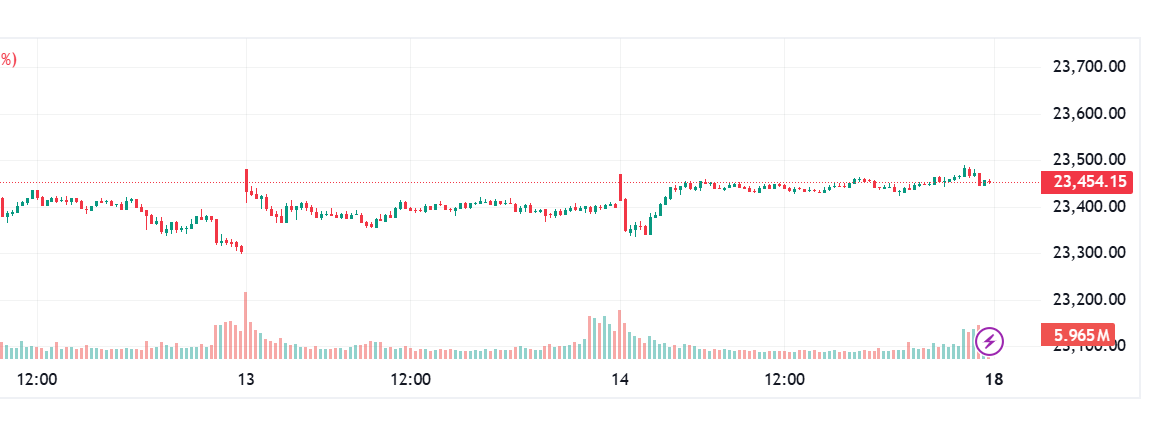In the fast-paced world of options trading, having the right tools and indicators can make all the difference. As we look ahead to 2024, understanding which indicators are most effective can significantly enhance your trading strategy.
Here’s a look at some of the best indicators for Option Trading, specializing in unique strategies and more
1. Moving Averages

Introduction to Moving Averages
Moving Averages (MAs) are fundamental tools in technical analysis, designed to smooth out price fluctuations and help traders identify trends. By averaging the price over a specific period, MAs provide a clearer view of the price trend without the noise of short-term volatility.
Ideal Use for Accuracy
The ideal use of MAs for accuracy is in trending markets. They are less effective during sideways or choppy market conditions where price fluctuations can lead to false signals. The key to using MAs effectively is to understand that they are lagging indicators; they follow the trend rather than predict new trends.
Accuracy Rate
The accuracy rate of MAs depends on the settings and the market conditions. No indicator can provide 100% accurate signals all the time. However, MAs can be quite reliable when used in conjunction with other indicators and analysis techniques.
Best Using Method
The best method for using MAs involves combining different types of MAs for various time frames. For instance, using a combination of SMA for the long-term trend and EMA for more recent price action can provide a balanced view. Traders often look for MA crossovers as signals: when a short-term MA crosses above a long-term MA, it may indicate a buying opportunity, and vice versa for selling.
Additional Tips
- Adjust the time period of MAs according to your trading style: shorter periods for day trading, longer for swing or position trading.
- Use MAs as dynamic support and resistance levels.
- Combine MAs with other indicators like RSI or MACD to confirm signals.
- Always consider the overall market context and not rely solely on MAs.
By integrating Moving Averages into your trading strategy with careful consideration and practice, you can enhance your ability to make informed trading decisions.
2. Relative Strength Index (RSI)

Introduction to Relative Strength Index
The Relative Strength Index (RSI) is a momentum oscillator that measures the speed and change of price movements. Developed by J. Welles Wilder, it oscillates between zero and 100 and is typically used to identify overbought or oversold conditions in a market.
Ideal Use for Accuracy
RSI is most accurate when used to complement other technical analysis tools. It’s ideal for spotting divergences between price movement and momentum, which can signal potential trend reversals. RSI works best in markets that are not trending strongly in one direction or the other.
Accuracy Rate
The accuracy of RSI signals can vary, but it’s known for its reliability when confirming trend formations or breakdowns. It’s important to note that no technical indicator is infallible, and RSI should be used in conjunction with other indicators and analysis methods.
Best Using Method
The best method for using RSI is to look for divergence between the indicator and price action as a sign of an upcoming reversal. Traders also use overbought (>70) and oversold (<30) levels as signals for potential reversals. However, during strong trends, the RSI may remain in overbought or oversold areas for extended periods.
Additional Tips
- Use a 14-day period for standard RSI calculation but adjust according to your trading style.
- Pay attention to RSI levels that historically have been significant for the specific asset you’re trading.
- Combine RSI with moving averages or trendlines to confirm trends and reversals.
- Always use stop-loss orders to manage risk when trading based on RSI signals.
Incorporating the RSI into your trading can provide valuable insights into market momentum and help you make better-informed decisions.
3. Bollinger Bands

Introduction to Bollinger Bands
Bollinger Bands are a technical analysis tool created by John Bollinger in the 1980s. They consist of three lines: the middle band is a simple moving average (SMA), typically over 20 periods, and the upper and lower bands are standard deviations away from the SMA.
Ideal Use for Accuracy
Bollinger Bands are ideally used to measure market volatility and identify ‘overbought’ or ‘oversold’ conditions. They work best in markets that are ranging rather than trending, as the bands can provide potential entry and exit points during price oscillations within the bands.
Accuracy Rate
The accuracy of Bollinger Bands as a trading signal varies with market conditions. They are more reliable when used in conjunction with other indicators, such as RSI or MACD, to confirm signals. No indicator can guarantee 100% accuracy, but Bollinger Bands are a valuable tool for assessing market volatility.
Best Using Method
The best method for using Bollinger Bands is to look for price action touching or crossing the bands combined with other signals. For example:
- A price touching the lower band might be an oversold signal, suggesting a potential long position.
- A price breaking through the upper band might indicate an overbought condition, suggesting a potential short position.
Additional Tips
- Adjust the standard deviation settings based on the asset’s volatility; higher volatility might require wider bands.
- Look for band contractions which may indicate a forthcoming increase in volatility.
- Use Bollinger Bands in combination with pattern recognition and other oscillators for confirmation.
- Always consider overall market trends and do not rely solely on Bollinger Bands for trading decisions.
Bollinger Bands can be an effective tool for traders looking to capitalize on market volatility and price patterns.
4. Volume Profile
Introduction to Volume Profile
Volume Profile is a trading tool that displays trading activity over a specified time period at certain price levels. It differs from volume indicators that show the amount of volume traded during a particular time period; Volume Profile shows volume traded at specific price levels.
Ideal Use for Accuracy
Volume Profile is ideally used to identify areas of high and low trading activity, known as High Volume Nodes (HVN) and Low Volume Nodes (LVN), respectively. It’s most accurate when used to find potential support and resistance levels, as these are areas where large amounts of trading activity have occurred.
Accuracy Rate
The accuracy of Volume Profile as an indicator can be high when it comes to identifying key price levels where significant trading has taken place. However, like all indicators, it should be used in conjunction with other forms of analysis to confirm trading decisions.
Best Using Method
The best method for using Volume Profile is to look for HVNs that can act as potential support or resistance areas. Traders also watch for LVNs as areas where price might move quickly due to the lack of historical trading activity.
Additional Tips
- Combine Volume Profile with other indicators like Moving Averages or RSI for stronger signals.
- Use it to identify “value areas” where the majority of trading volume has occurred.
- Pay attention to “Point of Control” (POC), the price level with the highest traded volume in the profile.
- Adjust the timeframe of the Volume Profile to match your trading style; intraday traders might use a daily profile, while longer-term traders might look at weekly or monthly profiles.
Volume Profile can provide valuable insights into market structure and trader behavior, helping you make more informed decisions.
5. MACD (Moving Average Convergence Divergence): A Momentum Tracker
Introduction to MACD
MACD is a trend-following momentum indicator that shows the relationship between two moving averages of a security’s price. Developed by Gerald Appel in the late 1970s, the MACD is calculated by subtracting the 26-period Exponential Moving Average (EMA) from the 12-period EMA.
Ideal Use for Accuracy
MACD is ideally used to identify changes in strength, direction, momentum, and duration of a trend in a stock’s price. It is most accurate when used in trending markets and can be less effective during sideways or choppy market conditions.
Accuracy Rate
The accuracy of MACD can vary depending on market conditions and settings. It’s known for providing reliable signals when it comes to confirming trend changes and momentum shifts when used with other indicators.
Best Using Method
The best method for using MACD involves monitoring the MACD line as it crosses above or below the signal line. Bullish signals are generated when the MACD line crosses above the signal line, while bearish signals are generated when it crosses below.
Additional Tips
- Look for divergence between MACD and price as it can indicate potential reversals.
- Pay attention to the MACD histogram for rapid changes in momentum.
- Adjust the time periods of the EMAs to fit your trading strategy.
- Combine MACD with other indicators like RSI or Bollinger Bands for confirmation.
By understanding and applying MACD correctly, traders can gain insights into market momentum and make more informed trading decisions.
6. Fibonacci Retracement
Introduction to Fibonacci Retracement
Fibonacci Retracement is a popular technical analysis tool that uses horizontal lines to indicate areas of support or resistance at the key Fibonacci levels before the price continues in the original direction. These levels are derived from the Fibonacci sequence and include 23.6%, 38.2%, 61.8%, and 78.6%.
Ideal Use for Accuracy
Fibonacci Retracement is ideally used to predict potential reversal points during retracements in a trend. It’s most accurate when the market is trending and less so during consolidations or range-bound markets.
Accuracy Rate
The accuracy of Fibonacci Retracement as a predictive tool can be significant when applied correctly, especially in conjunction with other indicators. However, it’s not foolproof and should be used as part of a broader trading strategy.
Best Using Method
The best method for using Fibonacci Retracement involves identifying the start and end points of a major price move to apply the retracement levels. Traders then watch for price action at these levels for potential entry or exit points.
Additional Tips
- Combine Fibonacci levels with other forms of technical analysis, such as trend lines or RSI, for stronger signals.
- Look for confluence where multiple Fibonacci levels align with other indicators.
- Use higher time frames for more reliable signals.
- Remember that these levels are not guarantees but rather potential areas of interest.
Fibonacci Retracement can be a powerful tool in understanding market behavior and identifying strategic points for transactions.
7. Stochastic Oscillator
Introduction to Stochastic Oscillator
The Stochastic Oscillator is a momentum indicator that compares a particular closing price of a security to a range of its prices over a certain period of time. It uses a scale of 0 to 100 to determine whether the market is in overbought or oversold conditions.
Ideal Use for Accuracy
The Stochastic Oscillator is ideally used in ranging markets to identify potential reversal points. It’s most accurate when the market is not trending strongly in one direction and can provide false signals in strong trending markets.
Accuracy Rate
The accuracy rate of the Stochastic Oscillator can be high when it’s used to signal potential turning points in a non-trending market. However, like all indicators, it should be used with other forms of analysis for the best results.
Best Using Method
The best method for using the Stochastic Oscillator involves looking for overbought conditions (above 80) and oversold conditions (below 20). A move above 80 indicates that the security is close to its high for the given time period, while a move below 20 indicates that it’s close to its low.
Additional Tips
- Look for divergences between the oscillator and price as they can indicate potential reversals.
- Use the %K and %D lines crossover as buy or sell signals.
- Adjust the time period and smoothing constants to fit your trading strategy.
- Combine with other indicators like Moving Averages or RSI for confirmation.
Incorporating the Stochastic Oscillator into your trading strategy can help you better time your market entries and exits.
